Лексические и синтаксические параметры академического текста: дискриминантный анализ
Aннотация
В статье представлены математические модели дифференциации академических текстов трех предметных дискурсов на русском языке (филологического, математического и естественнонаучного), которые являются основой разработки и автоматизации профилирования текстов. Наша модель включает индексы двух групп параметров, а именно, поверхностных (например, длина предложения) и синтаксических (например, среднее значение глаголов в предложении, среднее значение прилагательных в предложении, локальный повтор существительных и глобальный повтор аргументов). Мы определили и подтвердили 5 статистически значимых признаков из 45 лингвистических признаков, извлеченных из нашего исследовательского корпуса, состоящего из 91185 токенов. Дискриминантный анализ, осуществленный на основе этих функций, подтвердил валидность профилирования текстов основанного на параметричесом анализе. Наши результаты будут полезны профессиональным лингвистам, программистам и разработчикам учебных и контрольно-измерительных материалов при выборе и модификации текстов для целевой аудитории.
Ключевые слова: Профилирование текста, Лексические признаки, Автоматические профайлеры, Предметная область, Синтаксические признаки, Математическая модель, Дискриминантный анализ
К сожалению, текст статьи доступен только на Английском
Introduction
The modern paradigm of applied linguistics addresses numerous problems – for example, translation algorithms, Natural Language Processing, and text mining (lit.Russ. "intelligent" text analysis). Results of applied linguistics research are extensively applied, from selecting texts with the designated content to recommendations for modifying the text for a certain category of potential readers. At present, researchers and users have readily available several automated text analyzers like TextInspector, Lextutor, Coh-Metrix, ReaderBench, Textometer, and RuLingva. These systems compute more than 200 text features and provide researchers with materials for describing, comparing, and altering texts depending on the users' linguistic-pragmatic goals. For example, LexTutor (https://www.lextutor.ca/vp/eng/) classifies vocabulary by origin, while TextInspector (https://textinspector.com/) considers the Common European scale (eng. CEFR) (https://www.coe.int/ru/web/lang-migrants/cefr-and-profiles). However, none of the existing analyzers is a discourse profiler – i.e., they do not define the register, discourse, and the type of a text based on its linguistic features. Of interest for these systems is the identification of reference ranges for the parameter metrics which enables the classification of text types. The demand for such profilers is especially high when selecting texts for specific purposes (e.g., educational, monitoring, informative, suggestive), as well as for authorship identification or the selection of text materials for various categories of users.
This article aims to establish a list of typological linguistic features that differentiate texts corresponding to three subject discourses (i.e., Mathematical, Philological, and Natural Science). The mathematical model relies on a discriminant analysis that enables follow-up automated text profiling (i.e., the attribution of a text to a certain level of complexity and discourse type).
The hypothesis of this study is that academic texts of a predefined complexity (i.e., within the range of one academic year) and intended for use in various subject areas (i.e., Mathematics, Philology, and Natural Science) exhibit quantitative lexical and syntactic differences. Such differences are typological in nature and can lead to the identification of discourse type and even the author (source). The identification of discriminative features and the design of a mathematical model of the text further facilitate the inter- and intra-discourse classification of texts.
Our main research objective is to develop a mathematical model to predict the complexity of academic texts in Russian using a limited list of linguistic features. We also aim at providing researchers with a practical and reproducible route to developing new language resources for Russian as a low-resource language.
Literature review
The specificity of an academic (or educational or scientific) text lies in its communicative function and pragmatic component, namely, in its focus on comprehension from the target audience. Zherebtsova (2007: 29) emphasizes the importance of information transfer when defining an educational and scientific text as a written message characterized by semantic and structural completeness. As such, the information content of a text as a unit of discourse is largely determined by its linguistic features: morphological, lexical, syntactic, and discourse (Solnyshkina, Harkova, Kazachkova, 2020). These features reveal the specifics of the educational and scientific text in different ways, determining its perceived difficulty for various categories of linguistic profiles (Solnyshkina, Kazachkova, Harkova, 2020).
The perception of difficulty for oral and printed (electronic) texts is correlated to quantitative features that include text length, syllable or character means for words (i.e., word length), or word counts in a sentence (i.e., sentence length). These features are considered in statistical analyses of text complexity and their correlation to text difficult is linked to the capacity of working memory (Oborneva, 2006: 5).
Sentence length as a predictor of complexity is of particular interest because it relates to syntax. Inherently, syntax may be more complex for sentences with an increased number of words; thus, high values for this feature are indicative of potential difficulties in understanding the text (McNamara, Graesser, McCarthy & Cai, 2014: 2). Word length is evaluated in a similar manner: longer words require more time to comprehend, work with, and store for a short term (Vakhrusheva, Solnyshkina, Kupriyanov, Gafiyatova, Klimagina, 2021: 15). Shorter words are easier to read; moreover, they are easier to comprehend and disambiguate since they tend to have fewer senses (Kiselnikov, 2015: 4).
Other morphological features also play an important role in text comprehension – for example, the proportions of various parts of speech in the text. Corpus linguistics has developed methods for identifying genres based on the relative frequencies of individual parts of speech (Seifart, Danielsen, Meyer, Nordhoff et al., 2012: 10). Statistically significant differences in registers and types of discourses were validated in several languages (Biber, 2006: 261). For example, verbs overlap was confirmed to create a more cohesive event structure that is easier to comprehend using the situational model; this parameter is especially relevant in the analysis of narrative texts (McNamara, Graesser & Louwerse, 2012: 89–116). Similar patterns have also been identified in Russian texts (Zhuravlev, 1988: 84–150; Sirotinina, 2009: 312). For example, the mean adjective and noun counts, as well as the genitive case, were validated as reliable complexity predictors. The increase of genitive cases in biology texts from the 5th to the 11th grade is 7% (from 34% to 41%), while social science texts exhibit a more drastic increase from 23% to 38% (Gatiyatullina, Solnyshkina, Solovyev, Danilov et al., 2020: 393–398).
Linguistic features of text complexity also include relative predictors (i.e., measures based on the relation of specific groups of units to others): the nominative ratio of verbs to nouns and the descriptive ratio of adjectives to nouns (Martynova, Solnyshkina, Merzlyakova, Gizatulina, 2020: 72–80).
Lexical features relate to the overlap of individual lexemes. Research indicates the significance of local overlap of nouns – i.e., repetitions of the same lexeme within one sentence or in adjacent sentences -, as well as global repetitions within the entire text (Corlatescu, Ruseti & Dascalu, 2022: 354; McNamara, Graesser, McCarthy & Cai, 2014: 2). Similar features include local and global argument overlaps (Crossley, Varner, Roscoe & McNamara, 2013: 3) that consider noun, pronoun, or a noun phrase in one sentence as a co-referent of a noun, pronoun, or a noun phrase in another sentence (McNamara, Graesser, McCarthy & Cai, 2014: 90).
Researchers also highlight lexical diversity (TTR - Type Token Ratio; the ratio of words to word forms) as a complexity predictor (Graesser, McNamara, Louwerse & Cai, 2004: 194). With TTR=1.0, none of the words in the text are repeated; however, such texts are not natural since the absence of lexical repetitions increases the difficulty of texts. Low TTR values (˂ 0.5) indicate a high repetition of words, which positively impacts text processing. The target audience of these texts consists of speakers with a limited vocabulary, namely foreign language learners or young students (Malvern, Richards, Chipere & Durán, 2004). TTR is measured on texts no longer than 1000 tokens as lengthier sequences result in an increase of functional words on one hand, and a decrease in content words, on the other. TTR values measured on texts longer than 1000 tokens are considered unreliable; thus, these texts need to be divided into fragments on which TTR is measured separately (Vakhrusheva, Solnyshkina, Kupriyanov, Gafiyatova, Klimagina, 2021: 88–99).
A validated predictor for the complexity of academic texts is the Flesch-Kincaid Readability Index (FK), originally developed for texts in English (Flesch, 1948: 221–233) and adapted for the Russian language only at the beginning of this century (Solnyshkina and Kiselnikov, 2015). The popularity of this index was facilitated by two factors: ease of calculations (and subsequent successful automation) and its match to the academic age of the reader (i.e., the number of years of formal schooling). Currently, this formula is successfully used for a variety of purposes from matching books to reader vocabularies, to predicting the success of a website. This text readability index is measured based on two basic metrics – mean sentence length and mean word length (Solnyshkina and Kiselnikov, 2015). FK is widely used to assess text appropriateness for different categories of readers pertaining to the military, medical institutions, insurance companies, and even car dealerships.
The two most notable readability formulas for the Russian language were designed for texts containing various discourse types. First, FC (SIS) (eq. 1) was developed on the corpus of academic texts and validated in psycholinguistic experiments with school children:
(1) FC(SIS) = 208.7 – 2.6 × ASL – 39.2 × ASW
where ASL is the mean sentence length in tokens and ALS is the mean word length in syllables (Solovyev, Ivanov & Solnyshkina, 2018).
Second, the readability formula of Oborneva (2006) [FC(O), eq. 2] was developed on fiction texts; however, it provides overestimated results when applied to texts of other types:
(2) FC(O) = 206.835 – (1.3× ASL) – (60.1× ASW) (see Solnyshkina, McNamara & Zamaletdinov, 2022).
The index of abstractness is also recognized by many researchers as a complexity predictor (Solovyev, Ivanov & Akhtiamov, 2019: 215–227) since abstract concepts hinder text comprehension (Solnyshkina and Kiselnikov, 2015). This parameter is especially significant in the complexity assessment of texts intended for younger students who more easily understand concrete words and may struggle with abstract concepts (Vakhrusheva, Solnyshkina, Kupriyanov, Gafiyatova, Klimagina, 2021: 15).
Methods
The set of features as listed above enables not only to carry out a multi-factor analysis of the linguistic complexity of the text but also to define a profile of the text using a limited number of features (i.e., assign it to a certain type, discourse, and level of complexity).
The starting point for this study was the idea that academic texts exhibit a quantitative typology, namely their "homogeneity" to teach a certain subject to students of a certain grade. Typology as a method is based on the concept of “fuzzy sets” of elements in which the transition of an element (in our case, a text) from one class (category) to another is carried out gradually. Elements of a class possess two types of features: inherent features (i.e., features typical of a class) and specific, individual features. The transition of an element from one class to another implies the accumulation of typological features of another set. For example, the complexity of Mathematics texts for the 2nd and the 3d grades is supposed to be different, although linguistic differences between them are few and minor. However, these differences may be elicited in the metrics of morphological, lexical, and syntactic features. In contrast, when considering texts of the same complexity but different subject areas (e.g., texts used to teach Russian in the 2nd grade and texts used to teach Mathematics in the 2nd grade) we assume they differ in several features. Moreover, the list of these features may differ when comparing texts of the same subject, but of varying complexity.
Our study was carried out in three stages described subsequently:
(1) Preparation, cleaning, and corpus pre-processing
The corpus for this study was compiled from seven textbooks on three subjects (the Russian language, Mathematics, and Science) from the Federal list of textbooks of the Russian Federation (https://fpu.edu.ru/, Order of the Ministry of Education of Russia No. 254, May 20, 2020), summing up to a total size of 95377 tokens. The selection of the books was performed based on the expert opinion of teachers practicing in primary schools. The sub-corpora for the 3 subjects were balanced in terms of their size (see Table 1).
Table 1. Corpus Size
Таблица 1. Размер корпуса исследования
Discourse domain | Textbook size (in tokens) | Subcorpus size (in tokens) |
Philology | 13702 | 38478 |
20384 | ||
4392 | ||
Maths | 16991 | 28728 |
11737 | ||
Science | 19770 | 28171 |
8401 |
Meta-descriptions, prefaces, author’s introductory words, contents, illustrations, inscriptions, phrases like “Figure 1”, notes, self-control questions, laboratory tasks, chapter titles, subheadings, footers, and running headlines were deleted to ensure consistency of the language material at the pre-processing stage. The textbooks were divided into 87 texts of about 750 – 1000 tokens: 20 Mathematics texts, 30 texts from the textbooks used to teach the Russian language, and 37 texts from textbooks on Natural Science. The variation in the sizes of texts under study, i.e. the range of 750 – 1000, was caused by the following: 1) we followed the textbooks segmentation into chapters and did not add a fragment to a chapter which in Natural science varies within 700 – 1000 words; 2) we did not increase the recommended sample text size to be within the range of 700 – 1000 words (Biber, 2006). We also randomly selected 10 texts (3 in Mathematics, 3 in the Philology, and 4 in Natural Sciences) to test our model. These 10 texts were not used in the discriminant analysis.
(2) Measurement of metrics of 45 linguistic features with the help of the automatic analyzer RuLingva (https://rulingva.kpfu.ru/) and the analysis of 14 statistically significant features
The metrics of the linguistic features of the texts under study were calculated using the automatic analysis RuLingva (https://rulingva.kpfu.ru/). After the initial screening, we selected 14 of the 45 features calculated with RuLingva in accordance to the previous work performed by Solnyshkina, Solovyev, Gafiyatova, Martynova (2022): sentence length (mean words in a sentence), word length (mean syllables in a word, mean nouns per sentence, the mean verbs per sentence, mean adjectives per sentence, Flesch-Kincaid index – FK(SIS)), index of abstractness, local noun overlap, global noun overlap, local argument overlap, global argument overlap, lexical diversity (Type token ratio, TTR), the nominative ratio of verbs to nouns, the descriptive ratio of adjectives to nouns, number of one-syllable words, number of two-syllable words, number of three-syllable words, number of four-syllable words. All other features (e.g., number of nouns in different cases, number of tense forms of the verb, Flesch-Kincaid index (FK(O)) were excluded from the analysis based on the similarity of the values for these features across all three sub-corpora.
(3) Development of the profiling method based on a discriminant analysis of the metrics of linguistic features.
The statistical analysis of the 14 features from the 87 texts was carried out using STATISTICA. After checking for the normality of the distributions, non-parametric Kruskal-Wallis H tests were conducted to assess differences between the blocks since the features were not normally distributed.
The discriminant analysis was employed to identify typological features of the texts and to calculate the formulas for classifying texts by subject discourse. We used the Discriminant Analysis module in STATISTICA and calculated the values of Wilks lambda (λ) and F-criterion. Wilks lambda value (λ) close to 0 indicates good discrimination (i.e., the contrasted objects have statistically significant differences). The F value of a variable in contrasted objects also indicates their statistically significant differences, thus being a measure that has a unique contribution to predicting the classification of an element to a group. Thus, we assess the correctness of the classification of the texts from this study based on the values of λ Wilks and the F-criterion.
Research results
In accordance to our research method, 14 features were analyzed in detail. Columns III - V from Table 2 present the means and standard deviations of all features corresponding to the texts under this study. Column VI denotes statistically significant features with an asterisk * (p < .05). Kruskal-Wallis H test confirmed that most of the features of the texts, with the exception of the ‘abstractness index’ and ‘global noun overlap’ (lines 9 and 11), are statistically significant (see Table 2).
Table 2. Linguistic features of texts of three sub-corpora
Таблица 2. Лингвистические параметры текстов трех предметных подкорпусов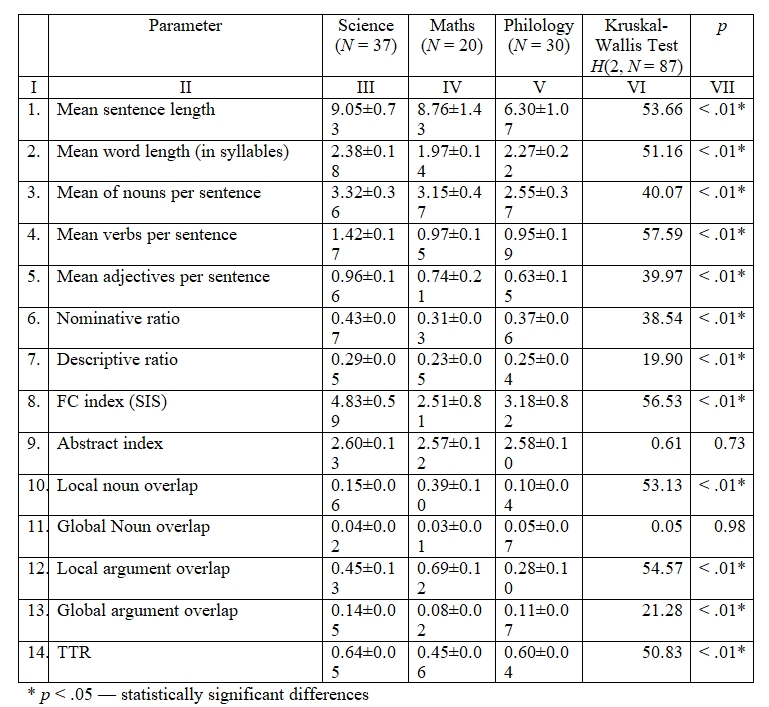
We consider for in-depth analysis all features that exhibit statistically significant differences between the three sub-corpora. Based on the data (see Table 2) and range diagrams (see Figures 1 a and b), we argue that the mean sentence length and mean syllables discriminate texts of different subject areas: sentences in Philological texts (sub-corpus of texts used to teach Russian) are the shortest – 6.30±1.07 words, and the longest sentences are in texts in the natural science sub-corpus – 9.05±0.73 words. The shortest words are used by the authors of the Mathematical texts – 1.97±0.14 words, and the longest appear in Natural Science texts – 2.38±0.18 words.
Figure 1. a) Mean sentence length (in words); b) Mean word length (in syllables)
Рисунок 1. а) Средняя длина предложения (в словах); b) Средняя длина слов (в слогах)
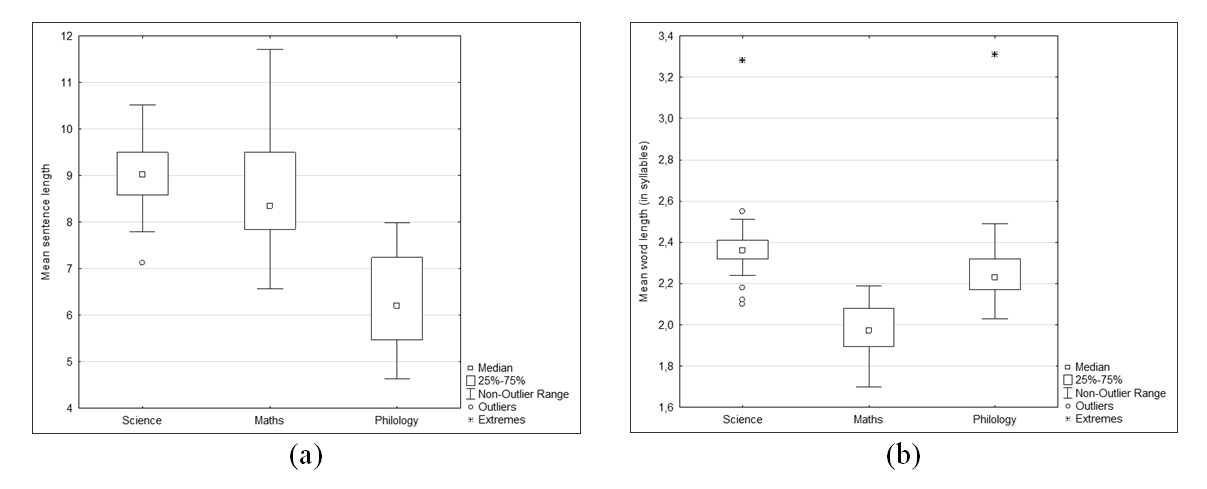
Figure 2 shows that Philological texts differ from the rest of the blocks: the number of nouns per sentence (2.55±0.37) in these texts is the lowest, while the same metric in Natural science (3.32±0.36) and Mathematical (3.15± 0.47) texts differs insignificantly.
Figure 2. Mean nouns per sentence
Рисунок 2. Среднее количество существительных на предложение
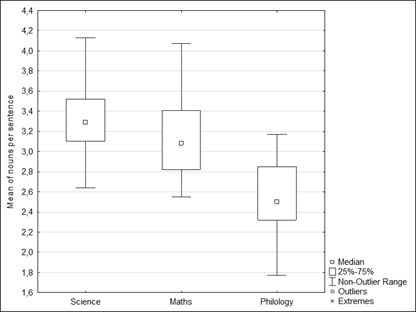
The mean numbers of verbs and adjectives per sentence are also the highest in natural science texts: with verbs having 1.42±0.17 and adjectives 0.96±0.16 per sentence (see Figures 3a and 3b). The differences in these features in texts of Philological and Mathematical sub-corpora are statistically insignificant.
Figure 3. a) Mean verbs per sentence; b) Mean adjectives per sentence
Рисунок 3. a) Среднее количество глаголов на предложение; b) Среднее количество прилагательных на предложение

The nominative ratio of verbs to nouns also exhibits significant differences (see Figure 4 a); the highest values are observed in the natural science corpus (0.43±0.07), while the lowest are in the Mathematical corpus (0.31±0.03). The Philological and Natural Science texts have similar values for these features: Philology (0.37±0.06) versus Natural Science (0.43±0.07). Higher metrics of the descriptive ratio of adjectives to nouns are also a characteristic of the texts of Natural Science (0.29±0.05), while Mathematical texts demonstrate a low descriptive ratio – 0.23±0.05. The metrics of Philological texts (0.25±0.04) in this respect are similar to the metrics of the Mathematical texts, rather than the ones of Natural Science ones (see Figure 4 b).
Figure 4. a) Ratio of verbs to nouns; b) Ratio of adjectives to nouns
Рисунок 4. a) Отношение глаголов к существительным; b) Отношение прилагательных к существительным

The Flesch-Kincaid index (SIS) is highest in natural science texts (4.83±0.59), while the metrics are quite similar in in Mathematical (2.51±0.81) and Philological (3.18±0.82) texts (see Figure 5).
Figure 5. Flesch-Kincaid (SIS)
Рисунок 5. Индекс Флеша-Кинкейда (SIS)
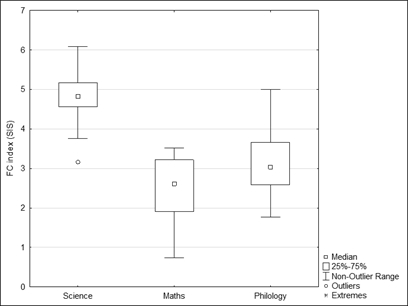
Mathematical texts demonstrate significantly higher metrics of local noun overlap (LNO=0.39±0.10) and local argument overlap (LAO=0.69±0.12). The values of these features are the lowest in the Philological texts (LNO = 0.10 ± 0.04, LAO = 0.28 ± 0.10), while the metrics for Natural Science texts occupy an intermediate position with LPS= 0.15 ± 0.06, and LAO = 0, 45±0.13) (see Figures 6a and 6b).
Figure 6. a) Local noun overlap; b) Local argument overlap
Рисунок 6. a) Локальный повтор существительных; b) Локальный повтор аргумента
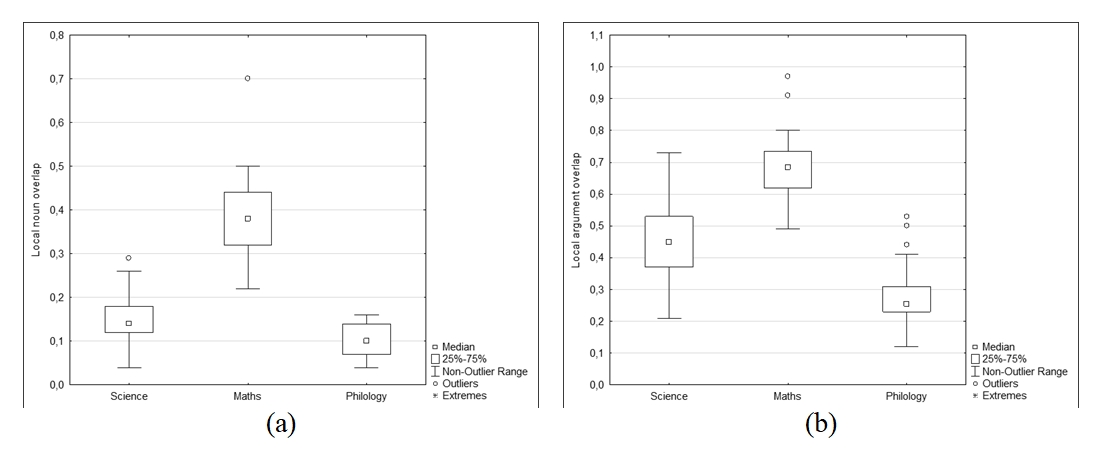
Figures 7 a and b show differences in metrics of global argument overlap (0.14±0.05) and lexical diversity (TTR) (0.64±0 .05). Global noun overlap in the Mathematical texts (0.08±0.02) are slightly lower than in the Philological texts (0.11±0.07), while the difference in the values of TTR of the Philological (0.60±0.04) and Mathematical (0.45±0.06) texts is higher.
Figure 7. a) Global argument overlap; b) TTR
Рисунок 7. a) Глобальный повтор аргумента; b) Лексическое разнообразие

The identified linguistic features of educational texts were used to develop a mathematical model for profiling texts of the three discourses. To design a predictive model, we employed a discriminant analysis, one of the most validated multivariate methods in style studies (Andreev, 2010: 100–110). Discriminant analysis was also used in attribution studies (i.e., authorship identification; Baayen, Halteren & Tweedie, 1996: 121–132; Holmes, Forsyth, 1995: 111–127; Stamatatos, Fakotakis & Kokkinakis, 2001: 193–214).
For the profiling technique, we used the 12 statistically significant features from Table 2. We considered a backward stepwise Discriminant Analysis that retained 5 variables (see Table 3). The discriminant analysis of the 77 texts used for training showed the following results: Wilks' Lambda λ = .03821, F (10.140)=57.619 , p < .001. The values of λ Wilks close to 0 indicate good discrimination of the contrasted objects. Based on the values of λ and F-criterion, we confirm the accuracy of the classification.
Table 3. Discriminant Analysis Results
Таблица 3. Результаты дискриминантного анализа
Features | λ Wilks' | λ Partial | F | p | |
1 | Mean sentence length | 0.067 | 0..760 | 12.633 | < .001 |
2 | Mean verbs per sentence | 0.108 | 0.474 | 44.368 | < .001 |
3 | Mean adjectives per sentence | 0.068 | 0.749 | 13.399 | < .001 |
4 | Local argument overlap | 0.078 | 0.657 | 20.838 | < .001 |
5 | Global argument overlap | 0.079 | 0.643 | 22.233 | < .001 |
Given the test set of 10 texts, the accuracy of our model proved to be as high as 90% since 9 out of the 10 tested texts were correctly classified (see Table 4).
Table 4. Classification matrix
Таблица 4. Классификационная матрица
Sub-corpora | Projected Classifications | |||
Accuracy (%) | Science | Maths | Philology | |
Science | 100.0% | 4 | 0 | 0 |
Maths | 100.0% | 0 | 3 | 0 |
Philology | 66.7% | 1 | 0 | 2 |
Total | 90.0% | 5 | 3 | 2 |
The scatterplot of the canonical values for canonical roots enables the identification of the contribution of each discriminant function in discriminating texts of each sub-corpora. As it can be seen from the diagram from Figure 8, the canonical function 1 (F1) differentiates Mathematics texts from philology and natural science texts: the higher the value of F1, the more likely it is that the text is Mathematical. Canonical function 2 (F2) enables us to differentiate Philology texts from Mathematics and Natural Science texts: the lower the value of F2, the more likely it is a Philological text. While inspecting the scatterplot, if the values of both canonical functions are negative, then the text is more likely to be classified as Philological; if the values of both functions are higher than zero, then the text is more likely to be classified as Mathematical.
Figure 8. Scatterplot of canonical values for canonical roots
Рисунок 8 Диаграмма рассеяния канонических значений для канонических корней
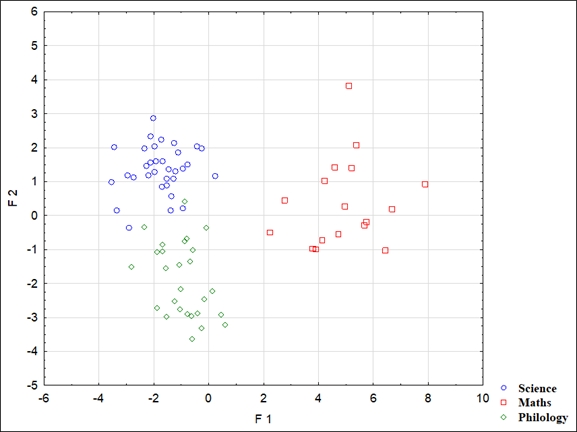
Based on the values of the standardized coefficients of canonical functions (see Table 5), we can define the impact of the linguistic features of the text on the values of canonical functions 1 and 2. Judging by the coefficients, the following linguistic features have the greatest influence on these functions: mean sentence length, mean verbs per sentence, and mean adjectives per sentence.
Table 5. Standardized coefficients of canonical functions
Таблица 5. Стандартизированные коэффициенты канонических функций
Text features | Acronym | Canonical Functions | |
F1 | F2 | ||
Mean sentence length | M(Sen/L) | 1.081 | 0.095 |
Mean verbs per sentence | M(VB/Sen) | -0.915 | 0.723 |
Mean adjectives per sentence | M(JJ/Sen) | -0.728 | 0.350 |
Local noun overlap | LocalNNOver | 0.716 | 0.335 |
Global argument overlap | GlobalArgOver | -0.598 | -0.035 |
Thus, the formulas for classifying texts by subject discourse are as follows:
F(Science) = -51.46+0.74*M(Sen/L)+47.67*M(VB/Sen)+21.75*M(JJ/Sen)+18.59*LocalNNOver+26.48* GlobalArgOver
F(Maths) = -51.21+7.65*M(Sen/L)+5.78*M(VB/Sen)+(-7.56)*M(JJ/Sen)+97.95*LocalNNOver+(-44.34)* GlobalArgOver
F(Philology) = -23.77+1.31*M(Sen/L)+28.55*M(VB/Sen)+11.93*M(JJ/Sen)+9.72*LocalNNOver+19.63* GlobalArgOver
Discussion
Text analysis showed that the educational texts from the three discourses exhibited statistically significant differences. For example, Natural Science texts differ from classroom texts on the Russian language and Mathematics by having longer sentences and higher nominative and descriptive ratios. The latter is probably caused by differences in their functions: Natural Science texts are supposed to create a holistic picture of the world and broaden the readers’ horizons. An additional specific feature of Natural Science textbooks considers the constituency of the sample that includes texts from natural history, social science, and historical facts; as such, longer and more complex sentences are more frequently encountered.
On average, the number of verbs and nouns per sentence is higher in texts of the Natural Science textbooks. This argues that the authors of these texts draw attention to the subject or object of the action (higher frequency of content words), as well as to the internal structure of events (high ratio of verbs) (see Seifart, Danielsen, Meyer, Nordhoff et al., 2012: 10). Natural science texts contain more narrations of events and more descriptions of facts than opinions; in contrast, Philological texts contain more opinions.
Mathematics textbooks have a higher nominative ratio and a larger number of nouns per sentence compared to Philological texts (see Figure 3) and the mean word length in Mathematical textbooks is lower than in the contrasted discourses. Moreover, Mathematical texts have a low lexical diversity (see Figure 7b) since Mathematics operates with specific terms (traditionally denoted by nouns), and the use of synonyms in this type of discourse is either not recommended or impossible. This can also explain the higher values of local argument overlap in Mathematical texts when contrasted to texts from the two other discourses.
Educational texts in the textbooks used to teach the Russian language in elementary school differ from texts in other discourses by having shorter sentences, arguable since a large proportion of texts are intended for memorization and further reproduction. Short sentences are necessary to develop basic skills in writing and spelling skills.
Conclusion
The academic texts from three subject discourses (i.e., Philological, Mathematical, and Natural Sciences) exhibit statistically significant differences on 12 linguistic features, namely: sentence length, word length, mean nouns per sentence, mean verbs per sentence, mean adjectives per sentence, local noun overlap, local argument overlap, global argument overlap, nominative ratio, descriptive ratio, Flesch-Kincaid index (SIS), and lexical diversity (TTR). These differences are caused by the changes in the functions of these texts and are manifested in their lexical and syntactic levels.
Based on the discriminant analysis, we designed a model of text profiling that includes 5 linguistic features, namely: mean sentence length, mean verbs per sentence, mean adjectives per sentence, local noun overlap, and global argument overlap. The automation of these features and the provided formulas for classification enable the design and development of text profilers demanded for textbook writing and editing. Our model also contributes to the design of a quantitative linguistic typology of Russian academic texts.
CorpusMaterials
Moro, M. I., Bantova, M. A., Bel'tyukova, G. V. et al. (2012). Matematika. 2 klass.Ucheb. dlya Obshcheobrazovat. Organizacij v2 ch. Ch. 1,6-e izd. [Mathematics. Grade 2. Textbook for secondary schools in 2 parts. Part 1, Edition 6.], Prosveshchenie, Moscow, Russia. ISBN: 978-5-09-028297-0 (In Russian)
Moro, M. I., Bantova, M. A., Bel'tyukova, G. V. et al. (2012). Matematika. 2 klassUcheb. dlya Obshcheobrazovat. Organizacij v 2 ch. Ch. 2, 6-e izd. [Mathematics. Grade 2. Textbook for secondary schools in 2 parts. Part 2, Edition 6.], Prosveshchenie, Moscow, Russia. ISBN: 978-5-09-028297-0 (In Russian)
Peterson, L. G. (2017). Matematika. 2 klass.V 3 ch.Chast' 1, Izd. 5-e [Mathematics. Grade 2. Textbook in 3 parts. Part 1, Edition 5], Yuventa, Moscow, Russia. ISBN: 978-5-9963-3238-0 (In Russian)
Peterson, L. G. (2017). Matematika. 2 klass.V 3 ch.Chast' 2, Izd. 5-e [Mathematics. Grade 2. Textbook in 3 parts. Part 2, Edition 5], Yuventa, Moscow, Russia. ISBN: 978-5-9963-3239-7 (In Russian)
Peterson, L. G. (2017). Matematika. 2 klass.V 3 ch.Chast' 3, Izd. 5-e [Mathematics. Grade 2. Textbook in 3 parts. Part 3, Edition 5], Yuventa, Moscow, Russia. ISBN: 978-5-9963-3240-3 (In Russian)
Dmitrieva, N. Ya., Kazakov, A. N. (2021). Okruzhayushchij mir: Uchebnik dlya 2 klassav 2 ch. Ch. 1. [Science. Grade 2. Textbook in 2 parts. Part 1.], Prosveshchenie, Moscow, Russia. ISBN: 978-5-0908-5490-0 (In Russian)
Dmitrieva, N. Ya., Kazakov, A. N. (2021). Okruzhayushchij mir: Uchebnik dlya 2 klassav 2 ch. Ch. 2. [Science. Grade 2. Textbook in 2 parts. Part 2.], Prosveshchenie, Moscow, Russia. ISBN: 978-5-0908-5488-7 (In Russian)
Ivchenkova, G. G., Potapov, I. V. (2018). Okruzhayushchij mir: Uchebnik dlya 2 klassa v 2 ch. Ch. 1. [Science. Grade 2. Textbook in 2 parts. Part 1.], Astrel', Moscow, Russia. ISBN: 978-5-358-19400-7 (In Russian)
Ivchenkova, G. G., Potapov, I. V. (2018). Okruzhayushchij mir: Uchebnik dlya 2 klassa v 2 ch. Ch. 2. [Science. Grade 2. Textbook in 2 parts. Part 2.], Astrel', Moscow, Russia. ISBN: 978-5-358-19903-3 (In Russian)
Ramzaeva, T. G. (2022). Russkij yazyk. 2 kl. v 2 ch. Ch. 1. [Russian language. Grade 2. Textbook in 2 parts. Part 1], Drofa, Moscow, Russia. ISBN: 9785090793919 (In Russian)
Ramzaeva, T. G. (2022). Russkij yazyk. 2 kl. v 2 ch. Ch. 2. [Russian language. Grade 2. Textbook in 2 parts. Part 2.] Drofa, Moscow, Russia. ISBN: 978-5-09-087981-1 (In Russian)
Solovejchik, M. S., Kuz'menko, N. S. (2021). Russkij yazyk. 2 klass.Uchebnik v 2 ch. Ch. 1. [Russian language. Grade 2. Textbook in 2 parts. Part 1.], Prosveshchenie, Moscow, Russia. ISBN: 978-5-09-081119-4 (In Russian)
Solovejchik, M. S., Kuz'menko, N. S. (2021). Russkij yazyk. 2 klass.Uchebnik v 2 ch. Ch. 2. [Russian language. Grade 2. Textbook in 2 parts. Part 2.], Prosveshchenie, Moscow, Russia. ISBN: 978-5-09-081121-7 (In Russian)
Благодарности
Работа выполнена за счет средств Программы стратегического академического лидерства Казанского (Приволжского) федерального университета («ПРИОРИТЕТ-2030»), Стратегического проекта №4.
Мы благодарим Лехницкую Полину Александровну, студентку Казанского федерального университета, за помощь в подготовке корпусов учебных текстов и проведении исследования.


















Список литературы
Список использованной литературы появится позже.